Last habitable landmass must lead covid–climate mobilisation
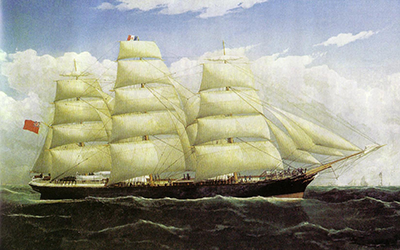
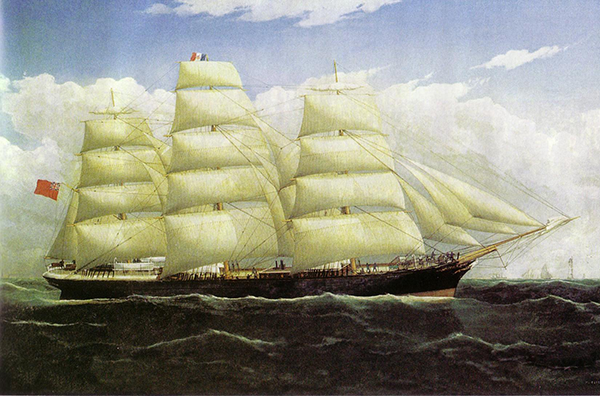
First to Demonstrate Frozen Commercial Success: Sailing from Port Chalmers in 1882, converted liner Dunedin demonstrated that meat could be exported around the planet, economically. Eight decades later, Mahurangi son Dr Ronald Locker belatedly addressed the downside, by demonstrating that frozen meat could also be tender. In the 20th century, vitamin-rich frozen food has a critical new role, to significantly reduce food waste and the associated greenhouse-gas emissions. oil on canvas Frederick Tudgay
Last habitable landmass to emerge, and to be inhabited, Aotearoa, must now play to its strengths by demonstrating life richly lived, after zero-carbon, and covid-19. Must, because New Zealanders, young and old, face a desperately grim future unless the world reforms its destructively dysfunctional ways.
Geographical isolation, combined with a belated but well-supported response, has resulted in Aotearoa having an official infection rate only a 68% higher than that of South Korea—as opposed to the United States’ shameless more than 1800% higher rate, by way of odious comparison. But while closing airports should be the first measure to contain a pandemic, climate and sea-level rise are no respecters of sovereignty. And, as a dress rehearsal for what unchecked global over-heating guarantees, covid-19 is graphically demonstrating that most of the world’s ill-cast leadingexcept that “lead” is the last thing today’s nominally democratically elected leaders do—they rule as the proxies of the plutocracy characters have so far not bothered to open the script, much less study their lines.
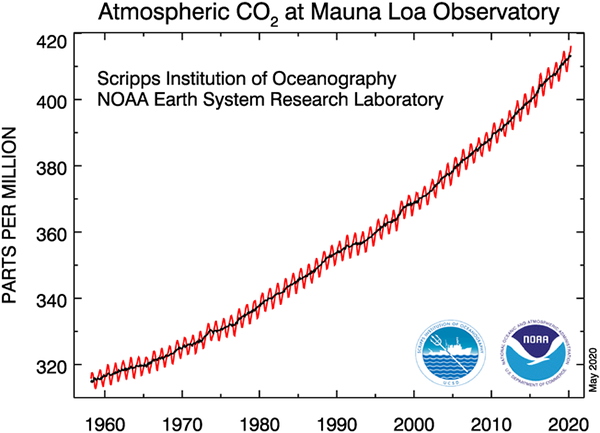
What Goes Up Stays Up: Headlines heralding a drop in greenhouse-gas emissions miss the opportunity to remind readers that while emissions can drop, the carbon already in the atmosphere persists there, doing its damage day after day, year after year, for hundreds of years. Here, in more than six decades of atmospheric-carbon-dioxide data, the impact of the 2007–08 financial crisis is all but indiscernible. plot Scripps Institution of Oceanography
New Zealanders have never been backward about being world-beating, whether sailing black-hulled America’s Cup yachts cargoes of frozen mutton to Londonhe may have been a Canadian-born Scotsman, but William Soltau Davidson’s two years as a South Island shepherd, and much more, made him a New Zealander then, even if he was buried in Edinburgh in a converted passenger liner. As Planet of the Humans argues—to the planetary consternation of renewable-energy zealots—it is not easy being green. To convincingly demonstrate zero-carbon, even at small-country scale, would be a global game-changer.
China’s emphatic containment of covid-19 has demonstrated what an decisive state can achieve. But between healthy scepticism for authoritarianism, and unhealthy xenophobia, citizens and leaders of more-or-less democratic countries are loath even to analyse why the response was successful. This puts the world’s first full democracy in a persuasive position, should it be the first to convincingly demonstrate a zero-carbon, pandemic-proofed economy. Norway is often cited for its net-zero-by-2030, goal. However, with a per-capita oil production on par with Saudi Arabia, Norway is in no position to champion zero-carbon, nor covid-19 response, despite its high ranking in the testing stakes—Norway is flattening its infection rate faster than Germany, but at a rate already more than Snells–Algies’ horrific 4½ times higher than Aotearoa, which, for two consecutive days recently4–5 May 2020, did not increase.
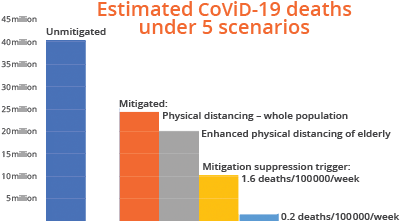
Billions of Infections, Millions of Lives: While the impatience to return to a semblance of pre-covid-19 complacency is entirely understandable, the magnitude of the pandemic, much as that of anthropogenic global heating, is a can that is kicked down the road at enormous peril to the planet’s 7.8 billion—headed for 11.2 billion—human inhabitants, and their fellow species. chart World Bank Blogs | labels Mahurangi Magazine |data Imperial College CoViD-19 Response Team
In respect to infection rates, covid-19 is an extremely poor analogy for atmospheric carbon dioxide. Because while the pandemic has demonstrated that greenhouse-gas emissions can be abruptly curtailed, most of that already in the atmosphere is there for an eternity. Carbon dioxide acts as the planet’s thermostat. But the remote that controls the thermostat, in effect, has superglue immobilising its down button. Lockdown has temporarily stopped the up button being jabbed, but with New Zealand’s government all too typical of governments everywhere impatient to resume spending on roads and other high-carbon projects, the jabbing is about to resume. Growing timber and locking it up in long-lived products such as durable houses for the more than one billion people who do not have adequate housing, and the billions who will be displaced by climate and sea-level rise, would turn down the thermostat, all things being equal. While it is probable the claim that an additional 0.9 billion hectares of planted forest could salvage a survivable climate significantly over-egged its potential, exactly the opposite is in full swing, thanks to the world’s unprincipled stampede to plant oil palm.
Translucent Democracy vs. Opaque Autocracy: That China has successfully contained covid-19, whereas the rest of the world has mostly allowed it to run rampant, points to dire democratic-dysfunctionality that, if unaddressed, will allow an increasingly unsurvivable climate to cause the death of not mere millions, but billions of the world’s projected 11-billion-by-2100 population. graph Mahurangi Magazine | data ecdc 8 June 2020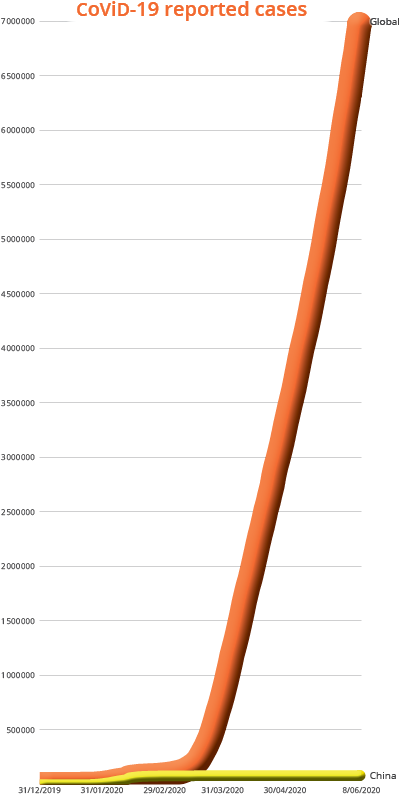
Human population has hopefully doubled for the last time. The last doubling took the 47 years following 1973. Had fossil-fuel combustion not been accompanied by the mother of all unintended consequences—global heating—human population may well have peaked without quite doubling over the next 100 years. As satisfactory as that counterfactual might have been for those for whom any suggestion that the planet is overpopulated now or will be in the future is deeply repugnant, the reality is that current growth rates will condemn an estimated 2–3.5 billion people to an unsurvivable climate. That is possibly the range of people who will be infected is this covid-19 pandemic, but enduring an illness that lasts only weeks, is one thing. Being subjected to a short and brutish lifetime in a climate where only the rich and the continuously air-conditioned, and those safely out of the each of sea-level rise, have any semblance of comfort, is quite another.
Michael Moore’s film is invoking the usual backlash against those who dare to venture that the planet is overpopulated. Questioning the wisdom of growth to the point where humans and their livestock—mostly cows and pigs—now make up about 96% of all mammalian biomass, and poultry, about 75% of all that which is avian, is to be named a misanthrope. George Monbiot, of his advocacy, alludes to Lord Byron:
There is pleasure in the pathless woods, there is rapture in the lonely shore, there is society where none intrudes, by the deep sea, and music in its roar; I love not Man the less, but Nature more.
It is also presumably possible to love humanity and the natural world equally—or even to love humankind more—but safely short of the point that humankind deprives itself of a survivable climate.
Rather than argue for a survivable climate, an actual misanthrope would relish the prospect of humankind multiplying unchecked until it checkmated itself and brought about plague and famine of biblicalor koranic diluvian proportions. Why a world plateauing at 11 or so billion is acceptable, but voluntarily electing to stop at 7.8 and softly recede to a remotely supportable, 1973-level, 3.9 billion is not, perhaps the newly formed militia of Michael Moore-censors might care to explain.
Without greenhouse gases, the climate of Planet Earth would be an unsurvivable average -18°. That its climate, over the last nearly 11 000 years, has been an imminently pleasant 33° warmer, is down to the conducive, average, 280-parts-per-million-pre-Industrial Revolution level of atmospheric carbon dioxide. But, in an unintentional, unfortunate experiment of geospheric proportions, that critical insultation component—the global thermostat—has been abruptly bumped up to 410 parts per million, in just a tiny, fifty-fifth of that time. If every last human perished in the next pandemic, or in a hideously more virulent or more transmissible mutation of this one, the possibility is that the full 66-metre extent of sea-level rise would play out before atmospheric carbon dioxide was safely re-sequestered, by geological-timescale processes.
Pandemic and War No Way to Address Overpopulation: Viewed at the scale of 199 years, wars and pandemics barely leave an impression. The only conceivable way global population can be prevented from precipitating a largely unsurvivable climate is if a generation of the world’s young people mobilise heroically, to not conceive. That, and all other generations lending a hand, to make the covid-19-lockdown look like a limbering up exercise. chart Mahurangi Magazine | data Our World in Data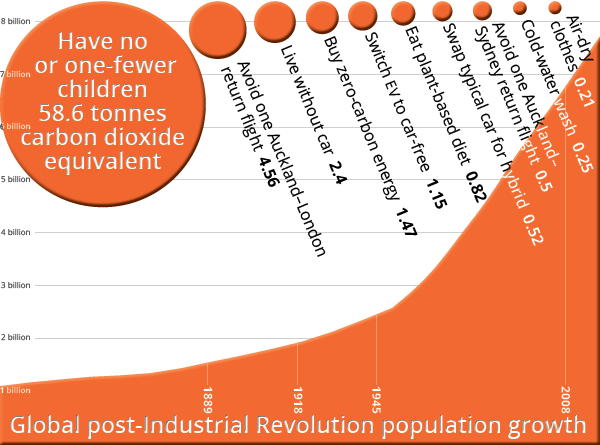
It shouldn’t need saying that pandemics, or wars, are no way to address anthropogenic human overpopulation. Given that to choose to not breed, or to bear fewer babies, is the greatest benefit a young person can directly bestow on the biosphere. And that includes reducing the pressures that stimulate the emergence of zoonotic coronaviruses, causing health systems to become pandemic trenches. It may already be too late for Gen-Zers to be the heroes, in which case Gen-Alphas must step up as the survivable-climate super heroes. A voluntary breeding moratorium is the only grassroots action capable of averting catastrophic climate consequences. Anything less will not dislodge the growth model on which all regimes, including covid-19-lockdown-darling Aotearoa, are predicated. As long as people breed, the steely fingers of the global plutocracy will not be prised from the levers of power. Without the financial growth that an ever-growing population makes child’s play, governments would be forced to consider Rooseveltian routes, and promptly adopt an economic approach fit-for-purpose for climate-salvaging mobilisation.
In Govt We Trust Not: Many may have already lost all faith in democracy delivering humankind from its own worst endeavours, but abdicating responsibility to strongmen, as demonstrated by Germany and Italy all too recently, can end very, very badly. Meantime, the United States, despite the more than a month’s warning given by it, has just surpassed Italy’s reported covid-19 infection rate, and is in diabolical pursuit of that of Spain and Ireland, chased hard by the United Kingdom—populist leaders seem hellbent on topping the infection-rate charts. Chart here updated 20241016 to 1958–2024. chart Pew Research Center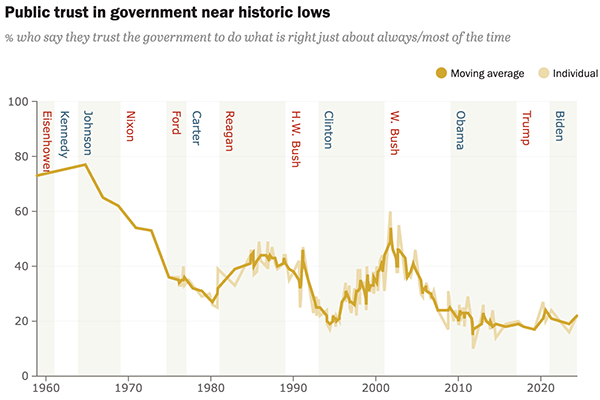
In wartime, pragmatism triumphs over ideology. During this covid-19 crisis, market-economy ideology got in the way of the early lockdowns that would have ensured little spread beyond China, where the disease was being so emphatically eradicated. Rather than use the covid-19 constraints as the opportunity to rebuild public health systems destroyed by 40 years of neoliberalism, and roll back the dismal toll of seasonal influenza, most countries that did lockdown are desperately reopening to save an economy that is predicated on, and preoccupied by, gratuitous consumerism, and its rapacious twin, tourism. But while the iconoclastic work of the Planet of the Humans is both necessary and laudable, its ideological, antitechnology conclusion is unnecessarily neoluddistic. Because much energy is used wantonly doesn’t make energy, or even its suppliers, the enemy. The enemy is the lazy, incurious thinking that led, for example, for Wellington’s zero-carbon trolleybuses, rather than being upgraded, being discarded for the impossible all-battery dream. But, equally, journey mitigation is relegated from frontpage, in favour of the grant designs of rather-be-dead-than-be-seen-on-a-bus-with-all-those-losers, born-again light-rail deluminaries.
Kero-Powered Milk Tanker: Coal-dried milk powder, admittedly value-added as infant formula, about to egregiously contribute to anthropogenic global heating by being flown to China. This example, of the market at is worst, demonstrates that the mobilisation to salvage a survivable climate must be directly commissioned, without the continuing three-decade delay that resembles the last four globally dysfunctional covid-19 months, in slow-mo. image FarmersWeekly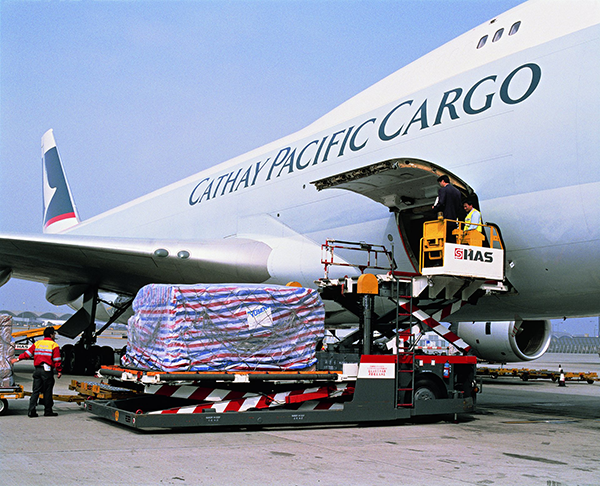
Instructively, many of the early warnings about the covid-19 pandemic were about the likely depth of the economic recession—assumed, unnecessarily, to be a given. Aside from the utter artificiality of economic recessions, what seemed to be of much less import was the famine that, without global intervention, would follow. The global-warming wise have long warned that it would be during periodic events, such as storm surges coinciding with spring high tides, that the implications of years of millimetre-per-year sea-level rise will manifest. Invariably, the simultaneous call is for climate action, lest the world become ungovernable; descend into anarchy. But surely, the far greater likelihood is that states become more autocratic, and more warlike. Donald Trump, for one, doesn’t appear to have ever visualised a path for the peaceful transition of power, even before his narrow, Electoral College victory. The concept has become so sullied and self-discredited, that, when democracy is needed most, many will not raise a hand to defend it.
Last Habitable Landmass to Emerge: Given that the future of tourism is long-stay, it’s fortunate that Aotearoa has a plethora of last-to-be stories to tell, beginning, surely, with the still-unfolding story of how the unique geology of Zealandia, and Aotearoa—even more topographically recently—came into being. And, rather than perpetuating the 100% Pure deceit, New Zealanders could repair and restore their trashed environment, and accelerate the work to improve the resilience of New Zealand’s 15 000-kilometre coastline, in preparation for its re-immersion. graphic Geological Society of America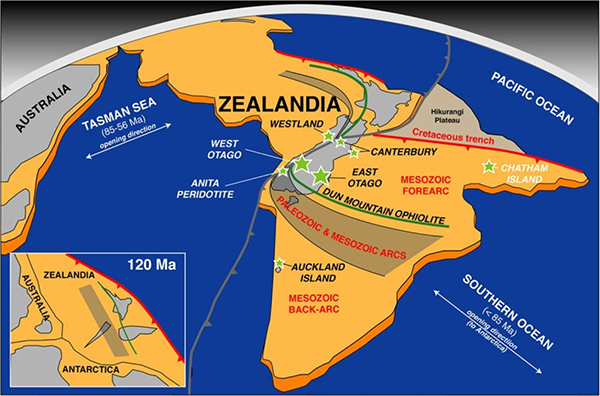
In the event, history will likely cite 2020 as the year that anthropogenic global heating saw the literal floodgates open to a new world order—or rather, disorder. Now, with the certitude of billions facing famine, it must be prayed that the same authorities warning of the greatest disruption since the Great Depression will realise that the desperate measures that various states resort to, could commence a thousand-year-reign of the demagogues, with scant pretence or recollection of democracy. New Zealand’s first demagogue, Robert Muldoon, far from hurting himself with his rude persona, endeared himself to the generations who had been sickened by a succession of insincere-sounding politicians. Winston Peters pulls the same trick—his apparent bluntness similarly masking chronic dissembling. Despite New Zealanders’ healthy 69% disapproval of Donald Trump, the next demagogue to steal an election in this constitution-free zone could only be an election away, in the fallout of the projected deepest recession in centuries. Far healthier would be for an emergency grand coalition to quickly impress upon New Zealanders that party politics will take a back seat and that the country will mobilise to build a zero-carbon and pandemic-free world, from Aotearoa out.
Now is the moment for New Zealanders to demonstrate that democracy can be restored, and can deliver, and to inspire the world with stories of the last habitable landmass to emerge, from the drowned continent of Zealandia, and its Polynesian settlement 700 years ago, and William Soltaunamed for George William Soltau b. 1 August 1775 or more probably George William Soltau b. 19 October 1801, one wonders? Davidson, and much, much more.
Post-covid-19 postscript When this article was published in May 2020, humanity still had every opportunity to eradicate covid-19, through a brief, rigorous period of elimination. Instead, an immense collective gamble was taken that the hitherto unheard-of technical challenge of developing a novel-coronavirus vaccine in time to contain a pandemic could be achieved. Heroically, vaccinologists achieved the seemingly impossible. World leaders to a man, however, squandered their responsibility to ensure all populations were vaccinated. The cost of just post-covid-19 syndromealso known as post-CoViD-19 syndrome, post-CoViD-19 condition, post-acute sequelae of CoViD-19 (PASC), chronic CoViD-19 syndrome (CCS) or, long CoViD-19, and just for the United States, and just for those already suffering the long-term condition, has been estimated at nearly four trillion. Casually consigning humanity to endemic covid-19 is bad enough, but it demonstrates that unless the world leaves its wickedly dysfunctional ways behind it, humanity—never mind its fellow species—will pay dearlywithout fear of hyperbole, 100s of trillions of dollars, and billions of lives for the failure of world leaders to democratically mobilise to salvage a survivable climate. covid-19, meanwhile, has killedor, to be pedantic: caused the excess mortality of more than 20 million.
January 2023
Achilles’ Heel of current strategies The following are the two concluding paragraphs of Asymptomatic Transmission, the Achilles’ Heel of Current Strategies to Control Covid-19, published 28 May 2020:
Ultimately, the rapid spread of Covid-19 across the United States and the globe, the clear evidence of SARS-CoV-2 transmission from asymptomatic personsArons MM, Hatfield KM, Reddy SC, et al. Presymptomatic SARS-CoV-2 infections and transmission in a skilled nursing facility. N Engl J Med. DOI: 10.1056/NEJMoa2008457, and the eventual need to relax current social distancing practices argue for broadened SARS-CoV-2 testing to include asymptomatic persons in prioritized settings. These factors also support the case for the general public to use face masks when in crowded outdoor or indoor spaces. This unprecedented pandemic calls for unprecedented measures to achieve its ultimate defeat.

Becoming Wise Before the Event: Despite now experiencing 17 pandemics—and 6 of those since 2002—the world was found to be pitifully ill-prepared for when, with predictable unpredictability, this current pandemic manifested. Preparing for the potentially far-deadlier effects of anthropogenic global heating, as well as being an inescapable existential imperative, can, simultaneously, better equip humanity to respond to epidemics, and prevent more becoming pandemics. Here, the initially all-but-imperceptible case-infection rates displayed for India and Indonesia were grave indicators of governments in desperate denial of their countries’ now-destined roles in the raging pandemic—and early exemplar Singapore demonstrates the ruinous consequences of neglecting its most vulnerable workers. Nigeria, however, scams all 207 million of its citizens, by testing fewer than 1% of them, thus hiding the appalling impact of the pandemic there. Australia long-since lost her battle to keep within cooee of covid-19-test-kit-exporter extraordinaire South Korea’s standout response. Aotearoa, meantime, has flat-lined in a good way. All countries’ infection rates are under-reported, some because a few cases, particularly early in the pandemic, are misdiagnosed, but in other countries monstrously, due to dysfunction and/or lack of transparency. The diameter of each line on this graph is proportional to the country’s population. graph Mahurangi Magazine | data Our World in Data 12 November 2020
Join FluTracking now and help prevent future pandemics…
Salutary Lesson in Seasonal Influenza: Physical distancing has also paid dividends in reducing the annual toll extracted by flu that, despite its deadliness, is treated as an inconvenience rather than the killer it is, particularly of the very young, the elderly, and the pregnant—“On average, approximately 400 deaths are attributed to influenza and its complications annually.” covid-19 provided the opportunity to begin collecting flu-symptom data earlier than was done 2018–2019. graph Department of Health Australia | Ministry of Health Aotearoa | labels Mahurangi Magazine
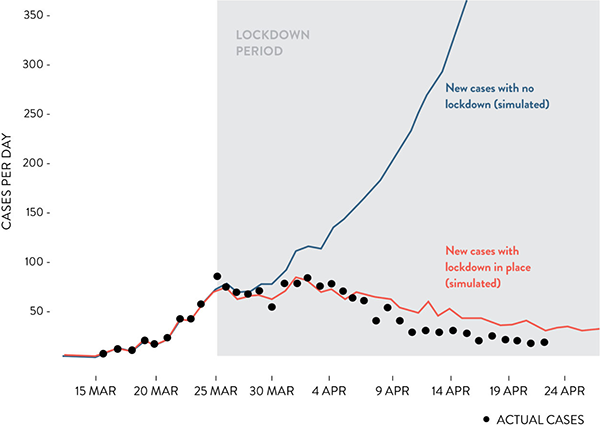
New Zealand’s Altered Future: Moving nine days faster than Ireland, and more emphatically physically distancing, Aotearoa has avoided Ireland’s near vertical trajectory—until the middle of May—of reported covid-19 cases. Ireland’s prime minister then donning his sweats was perhaps great optics, but responding to, for example, fellow general practitioner Dr Marcus de Brun, or to nursing-home representatives more than seven weeks earlier, would have constituted a far more heroic course of action. Aotearoa, for its own survival, now needs to convince the world to alter its determinedly fossil-fuelled future. chart New Zealand Geographic | Te Pūnaha Matatini
